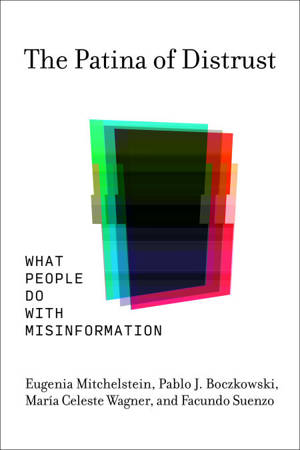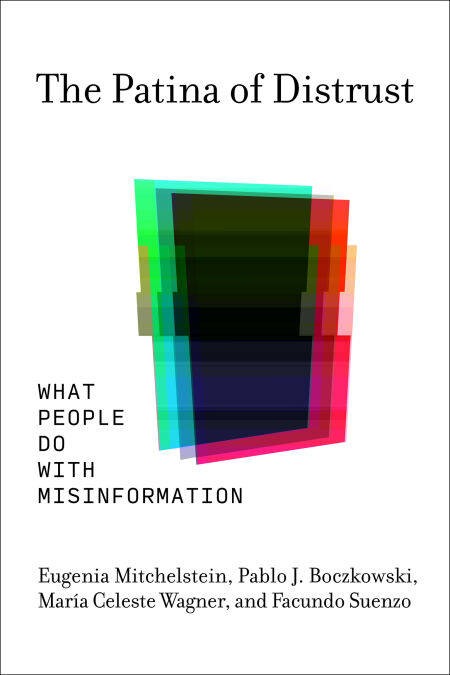
Je cadeautjes zeker op tijd in huis hebben voor de feestdagen? Kom langs in onze winkels en vind het perfecte geschenk!
- Afhalen na 1 uur in een winkel met voorraad
- Gratis thuislevering in België vanaf € 30
- Ruim aanbod met 7 miljoen producten
Je cadeautjes zeker op tijd in huis hebben voor de feestdagen? Kom langs in onze winkels en vind het perfecte geschenk!
- Afhalen na 1 uur in een winkel met voorraad
- Gratis thuislevering in België vanaf € 30
- Ruim aanbod met 7 miljoen producten
Zoeken
The Patina of Distrust E-BOOK
What People Do with Misinformation
Eugenia Mitchelstein, Pablo J. Boczkowski, Maria Celeste Wagner, Facundo Suenzo
E-book | Engels
€ 59,14
+ 59 punten
Omschrijving
The dynamics of news reception during the 2019 Argentine elections, and how distrust of the media can protect audiences from both misinformation and attempts to correct it.
The year 2016 marked a profound turning point in global politics. In June, the United Kingdom voted in favor of Brexit, choosing to leave the European Union. Just five months later, the United States elected Donald Trump as its president. In the wake of these momentous events, a prevailing narrative emerged, which focused on the role of misinformation in reshaping political landscapes. However, a critical aspect of this phenomenon remained unexplored—the dynamics of reception.
In The Patina of Distrust, Eugenia Mitchelstein, Pablo Boczkowski, María Celeste Wagner, and Facundo Suenzo dive deep into this overlooked facet by zeroing in on the reception of misinformation.
Central to the book is the development of the concept of “patina of distrust.” Much like the protective layer that accumulates over time on artworks, this societal patina serves as a buffer, shielding audiences to some extent from the harmful effects of misinformation and the attempts to rectify it. This book offers a historically grounded mixed methods study of news reception in Argentina’s 2019 presidential election, drawing from interviews, survey data, and experiments. The authors also include a coda that addresses the pandemic and the election of current Argentine president Javier Milei in 2023, bringing the analysis up to date with the current right-wing populist moment.
The year 2016 marked a profound turning point in global politics. In June, the United Kingdom voted in favor of Brexit, choosing to leave the European Union. Just five months later, the United States elected Donald Trump as its president. In the wake of these momentous events, a prevailing narrative emerged, which focused on the role of misinformation in reshaping political landscapes. However, a critical aspect of this phenomenon remained unexplored—the dynamics of reception.
In The Patina of Distrust, Eugenia Mitchelstein, Pablo Boczkowski, María Celeste Wagner, and Facundo Suenzo dive deep into this overlooked facet by zeroing in on the reception of misinformation.
Central to the book is the development of the concept of “patina of distrust.” Much like the protective layer that accumulates over time on artworks, this societal patina serves as a buffer, shielding audiences to some extent from the harmful effects of misinformation and the attempts to rectify it. This book offers a historically grounded mixed methods study of news reception in Argentina’s 2019 presidential election, drawing from interviews, survey data, and experiments. The authors also include a coda that addresses the pandemic and the election of current Argentine president Javier Milei in 2023, bringing the analysis up to date with the current right-wing populist moment.
Specificaties
Betrokkenen
- Auteur(s):
- Uitgeverij:
Inhoud
- Aantal bladzijden:
- 300
- Taal:
- Engels
Eigenschappen
- Productcode (EAN):
- 9780262381123
- Verschijningsdatum:
- 27/10/2025
- Uitvoering:
- E-book
- Beveiligd met:
- Adobe DRM
- Formaat:
- ePub

Alleen bij Standaard Boekhandel
+ 59 punten op je klantenkaart van Standaard Boekhandel
Beoordelingen
We publiceren alleen reviews die voldoen aan de voorwaarden voor reviews. Bekijk onze voorwaarden voor reviews.









